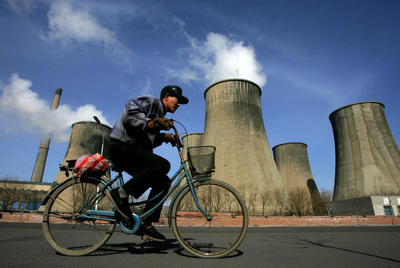The most recent IEA World Energy Outlook expects that demand for coal will increase another 25 per cent between 2009 and 2035. Since coal is one of the primary environmental polluters, its utilisation is subject to mounting environmental pressure.
The tensions between the use of coal for power generation, economic development and the increasing demand for environmental protection are mounting but manageable. The development and application of clean coal technologies (CCTs) are key to reconciling the tensions between coal use and the environment. CCTs, which cover technologies ranging from the preparation of coal through combustion and the clean up of waste gases to carbon capture and storage (CCS), will reduce the pollution emission intensity of coal and make coal cleaner.
But all this does not come automatically. China’s experience shows that much of its current emissions are due to its lack of adoption of available CCTs. Legal and fiscal regimes, with appropriate penalties and incentives, should therefore be established and enforced to encourage coal users — particularly the large-scale users such as steel makers and power generators — to use CCTs.
Fortunately, while CCTs typically incur additional costs, they can also provide economic benefits in addition to environmental ones. For example, Integrated coal Gasification Combined Cycle power plant technology can increase efficiencies by 20–30 per cent compared with conventional coal-fired power plants; the captured carbon dioxide from CCS power plants can be injected into oil fields to increase the oil recovery rate by 4–18 per cent; and carbon storage technologies, such as the creation of bio-charcoal, can improve soil fertility, agricultural productivity and water quality. CCTs can also bring new export opportunities for developing countries. Upgraded low-rank coal — such as brown coal in Indonesia, which has had no previous market — may develop export opportunities.
Despite the economic and environmental benefits, however, many developing countries do not use CCTs. Instead, coal-fired power plants with little application of CCTs are concentrated in, or even relocated to, developing countries. For example, the Electricity Generating Authority of Thailand built coal-fired power plants in its neighbouring countries after facing internal public resistance to coal-fired power plants. Such relocations usually worsen the emissions performance of these plants: if the power plants were built in Thailand, the Thai policy and regulatory regime would have led to the installation of better and more CCTs.
Developing countries are accepting new investment in coal-fired power generation without CCTs because there is a lack of public awareness and policy priority, and the institutional, financial and economic capacities are not in place. Communities and governments in developing countries often place a higher priority on improving income and economic development rather than investment in reducing pollution. And higher capital costs and a lack of ownership of the technologies often deter developing countries from adopting them. Even if developing countries wish to reduce pollution, they often do not have an adequate legal regime and the technical capacity to pursue this.
Developing countries are essential and the most cost effective players to improving the environmental performance of coal through the promotion of CCTs globally. It is projected that more than 96 per cent of growth in demand for coal between 2009 and 2035 will be from non-OECD countries. But their low-level uptake of CCTs implies that the net marginal benefits of promoting CCTs would be higher. Thus, making coal use cleaner in developing countries is environmentally important and economically effective.
International solutions are demanded and could be beneficial. Many developing countries need international finance generated from cooperation to invest in CCTs, such as financial aid, technical transfers and cooperation mechanisms like the Clean Development Mechanism. The transfer of CCTs, including low carbon technologies, could play a critical role in encouraging developing countries such as China and India to enter into a post-Kyoto Protocol agreement. In East Asia, Japan has proposed a post-Kyoto Protocol emission-reduction credit mechanism — the ‘bilateral offset crediting mechanism’. This will provide support and incentives to the Japanese private sector to export emission reduction and low carbon technologies to developing counties such as India, Indonesia and Vietnam. Through this mechanism, Japan expects to benefit from emission reduction credits, while the countries receiving the technologies will get high-end, efficient technology on competitive terms. Such a win–win outcome is likely to improve global environmental outcomes for coal power generation in a cost effective way.
Xunpeng Shi is an Energy Economist and Brett Jacobs is Chief of Energy Unit at the Economic Research Institute for ASEAN and East Asia, Indonesia.
This article was originally published here by World Energy Monitor.

